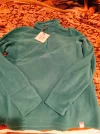auldies
Active Member
- Time of past OR future Camino
- Camino Frances (2016)
Well, it's only 4 weeks until we hopefully take our first Camino step and still I have not purchased my jacket. 
I have read and reread many/most of the threads relating to fleece and/or merino and I am even more .
.
I have also shopped around and tried some on but haven't found anything suitable and reluctant to order online in case I pay a whole lot of dollars and get it wrong.
Is a fleece 100% polyester?
Is merino a fleece?
Are they the same thing?
Which is best and why?
Many members list a fleece in their packing lists but no specifics.
What would be really helpful for me is if members could name their fleece/jacket (a link or photos would be even better) and tell me why they like it and if they would recommend it.
I do have a waterproof jacket but want something for warmth in the mornings and evenings.
Thanks everyone for your help and apologies for revisiting this topic.
I have read and reread many/most of the threads relating to fleece and/or merino and I am even more
I have also shopped around and tried some on but haven't found anything suitable and reluctant to order online in case I pay a whole lot of dollars and get it wrong.
Is a fleece 100% polyester?
Is merino a fleece?
Are they the same thing?
Which is best and why?
Many members list a fleece in their packing lists but no specifics.
What would be really helpful for me is if members could name their fleece/jacket (a link or photos would be even better) and tell me why they like it and if they would recommend it.
I do have a waterproof jacket but want something for warmth in the mornings and evenings.
Thanks everyone for your help and apologies for revisiting this topic.


























